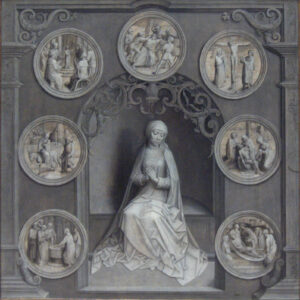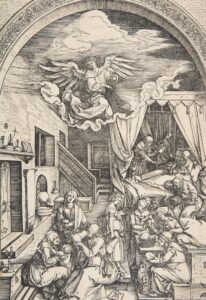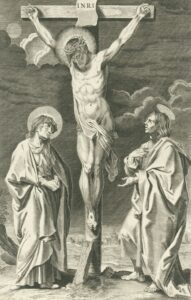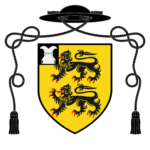“Forget not the Groanings of thy Mother”
by Fr. William Rock, FSSP
In a previous article it was related that the 40 days between the Feast of the Transfiguration and the Exaltation of the Holy Cross represent, through the lens of Our Lord’s Resurrection, a recapitulation of the 40 of Days of Lent with the Feast of the Exaltation being a recapitulated Good Friday. This all being the case, it is not unreasonable to ask if there is, following this recapitulated Good Friday on September 14th, a recapitulated Holy Saturday on the following day, September 15th.
Holy Saturday, for its part, marks the day when Our Lord’s Body rested in the tomb and His soul abided in the Limbo of the Fathers. It was also on this day that only Our Lady, of all of His disciples, kept faith in her Son. On this point, in his entry for Holy Saturday, Dom Guéranger wrote the following:
And now let us visit the holy Mother, who has passed the night in Jerusalem, going over, in saddest memory, the scenes she has witnessed. Her Jesus has been a victim to every possible insult and cruelty; He has been crucified; His precious Blood has flowed in torrents from those five Wounds; He is dead, and now lies buried in yonder tomb, as though He were but a mere man, yea the most abject of men. How many tears have fallen, during these long hours, from the eyes of the daughter of David!…Mary alone lives in expectation of His triumph. In her was verified that expression of the Holy Ghost, where, speaking of the valiant woman, He says: “Her lamp shall not be put out in the night” (Prov. xxxi. 18). Her courage fails not, because she knows that the sepulchre must yield up its Dead, and her Jesus will rise again to life. St. Paul tells us that our religion is vain, unless we have faith in the mystery of our Lord’s Resurrection: where was this faith on the day after our Lord’s death? As it was her chaste womb that had held within it Him whom heaven and earth cannot contain, so, on this day, by her firm and unwavering faith, she resumes within her single self the whole Church. How sacred is this Saturday, which, notwithstanding all its sadness, is such a day of glory to the Mother of Jesus! It is on this account that the Church has consecrated to Mary the Saturday of every week.1
Providentially, the day following the Feast of the Exaltation of the Holy Cross is a feast of Our Lady, a feast whose object is the sufferings of the Mother of God, including those she experienced during the Passion of her Son – the Feast of the Seven Sorrows of the Blessed Virgin Mary. As with the Exaltation of the Holy Cross, this September Feast of the Seven Sorrows2 can be seen as a recapitulation, through the lens of Our Lord’s Resurrection, of what was observed during Holy Week.

But this September Feast of the Seven Sorrows serves another purpose. On the 8th of September, Holy Mother Church celebrates the Feast of the Nativity of the Blessed Virgin Mary. The September feast of the Seven Sorrows falls on the Octave Day of Our Lady’s Nativity. So not only can the September Feast of the Seven Sorrows be seen as a recapitulated Holy Saturday, it is also connected with the Feast of the Nativity of Our Lady.
As such, it can be argued that there is a fittingness to having this Feast on the Octave Day of Our Lady’s Nativity. The Octave Day of Our Lord’s Nativity marks Our Lord’s Circumcision, when He first shed His Blood for us and received His Name, which means “Savior” or “the Lord saves.”
In the 1957 translation of the Raccolta – a book which is a collection of the various prayers which were then indulgenced – is found the meanings the Church has recognized in these two interrelated events – Our Lord’s Circumcision and the conferral of His Name – on the Octave Day of His Nativity. She expresses herself as follows: “Jesus, sweetest Child, wounded after eight days in Thy circumcision, called by the glorious Name of Jesus, and at once by Thy Name and by Thy Blood foreshown as the Savior of the world, have mercy on us.”3
Just as the events which occurred eight days after Our Lord’s birth foreshadowed, at least in part, His mission, it is fitting that there be a feast around the birth of Our Lady which expresses the same on her behalf. There cannot be a complete unity of expression between Our Lord and Our Lady on these points as Jewish baby girls do not undergo the rite of Circumcision on the 8th day after their birth. But having a feast on the Octave Day of her Nativity which touches on the newborn Queen’s future sufferings mirrors well the feast on the Octave Day of her Son’s Nativity which touches on His future sufferings. For just as Our Lord was predestined to be the Man of Sorrows, so was Our Lady predestined to be Our Lady of Sorrows. Even more, for, as the Church sings in the Communion for the feast of her sorrows, Our Lady merited the palm of Martyrdom as she stood at the foot of the Cross. She is rightly and properly titled, then, “the Queen of Martyrs.” Additionally, just as the Octave Day of Our Lord’s Nativity also commemorates Our Lord’s reception of His Name, so within the eight days of the Nativity of Our Lady, the Church keeps the feast of the Most Holy Name of Mary. This Feast of the Most Holy Name of Mary falls on the 5th Day of the Nativity of Our Lady, that is September 12th.4 So not only does this time of the Liturgical Year provide the faithful a recapitulation of Lent, it also serves as a mirror of Our Lord’s Nativity through these feasts of Our Lady.

And just as Our Lord underwent His Passion and Death for our sake, so did Our Lady undergo her Sorrows for us also, the modes being different, of course. For we read in the Book of St. John’s Apocalypse, the Book of Revelation, “And a great sign appeared in heaven: A woman clothed with the sun, and the moon under her feet, and on her head a crown of twelve stars. And being with child, she cried travailing in birth: and was in pain to be delivered…And she brought forth a man child, who was to rule all nations with an iron rod. And her son was taken up to God and to his throne” (Apo 12:1-2, 5). While these verses can admit of various, non-contradictory interpretations, one interpretation understands this woman symbolizing Our Lady, and the child symbolizing Our Lord. After all, He is to “rule all nations” and was taken up to the Throne of God, being equal with God. But this leaves the issue of her “travailing in birth” and being “in pain to be delivered,” for Our Lady did not suffer any labor pains in the birth of Our Lord.5 So, the questions must be asked, for whom is she suffering these labor pains and what exactly are these pains?
To find an answer to these questions, it should be noted that what was quoted earlier as “and being with child” is more an interpretation than a literal translation. The Latin, following the Greek, is “et in utero habens,” literally, “having” or “holding in the womb.” The Greek and Latin do not specify how many children the woman is holding in her womb, just that she is expecting. Giving this text as “being with child” reflects what follows in the proximate verses, but this is perhaps too restrictive. As it will be explained shortly, the more vague, “holding in her womb,” conveys a deeper spiritual reality. Additionally, it should also be noted that what is translated as “was in pain” in the Greek (“βασανιζομενη”) comes from the word “to torture,” the Latin being “cruciatur,” literally meaning she is being crucified, tormented, tortured, in order that she may deliver. These are not normal labor pains.

A few verses later, St. John explains that the woman had other children, namely, those “who keep the commandments of God and have the testimony of Jesus Christ” (12:17). Surely, she held these other children in some way in her womb, in some way gave birth to them. And would not these “who keep the commandments of God and have the testimony of Jesus Christ” be all true Christians? Therefore, all true Christians are children of this woman, the Blessed Virgin Mary, held in her womb in a certain manner and then born by her, in pains and sufferings which are compared to being tortured, being crucified. This reinforces the interpretation which says that at the Foot of the Cross, when Our Lord said to Our Lady and to St. John, “behold thy son…behold thy mother” (19:26-27), that Our Lord was giving His Mother as Mother to all of the Faithful in the person of St. John. It was not by accident that this occurred at the Foot of the Cross, for here she suffered, was crucified, tormented, tortured, in her Sorrows so that she might give supernatural life to us, her children, as a mother suffers for her natural children.
It is written in the book of Sirach, “forget not the groanings of thy mother” (7:29) which she suffered in giving you birth. If such is true regarding our natural mothers, how much more so should this apply regarding our Mother in the spiritual life, in the life of grace?
Fr. William Rock, FSSP was ordained in the fall of 2019 and is currently assigned to Regina Caeli Parish in Houston, TX.
- Guéranger, Prosper. The Liturgical Year, vol. 6 (Passiontide and Holy Week). Trans. Shepherd, Laurence. (Fitzwilliam: Loreto Publications, 2000), pp. 547-9.
- The Seven Sorrows of the Blessed Virgin Mary are also commemorated on the Friday of Passion Week, the Friday before Good Friday.
- The Raccolta. Trans. Christopher, Joseph P., Spence, Charles E., Rowan, John F. (Fitzwilliam: Loreto Publications, 2004 a reprint of Boston: Benzinger Brothers, Inc., 1957), p. 69 (126, V).
- Previously kept on the Sunday within the Octave of the Nativity of the Blessed Virgin Mary.
- See Ott, Ludwig. Fundamentals of Catholic Dogma. Trans. Lynch Patrick. Edited by Bastible, James. Updated by Fastiggi, Robert. (Baronius Press, 2018), p. 222.
September 8, 2023









